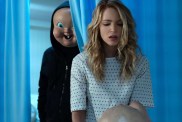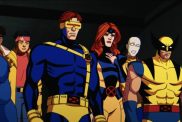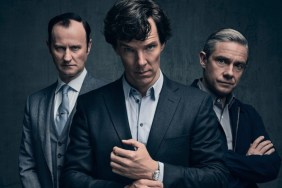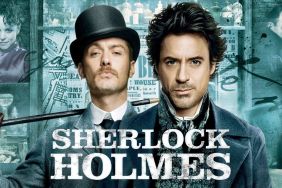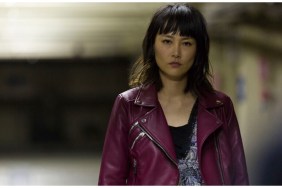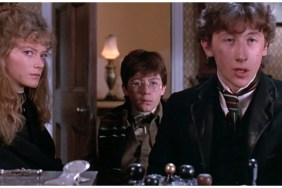Cast:
Robert Downey Jr. as Sherlock Holmes
Jude Law as Dr. John Watson
Rachel McAdams as Irene Adler
Mark Strong as Lord Blackwood
Eddie Marsan as Inspector Lestrade
Robert Maillet as Dredger
Geraldine James as Mrs. Hudson
Kelly Reilly as Mary Morstan
William Houston as Constable Clark
Hans Matheson as Lord Coward
James Fox as Sir Thomas
William Hope as Ambassador Standish
Clive Russell as Captain Tanner
Oran Gurel as Reordan
David Garrick as McMurdo
Directed by Guy Ritchie
Summary:
Masterfully crafted by Guy Ritchie, this refreshing take on Sir Arthur Conan Doyle’s sleuth is a great vehicle for Downey to create another distinctively eccentric character.
Story:
Sherlock Holmes and Dr. Watson (Robert Downey Jr. and Jude Law) have officially wrapped up their last case together by capturing Lord Blackwood (Mark Strong), a madman responsible for the death of five women in his dabblings with black magic. After Blackwood is tried and hung, he seemingly returns from the dead, so the duo have to continue their partnership to solve the case. Then Holmes’ ex-girlfriend Irene Adler (Rachel McAdams), a jewel thief and criminal in her own right, seems to somehow be involved in the case.
Analysis:
Whether or not you’re a fan of Sir Arthur Conan Doyle’s stories, you probably have a lot of questions and expectations about how Robert Downey Jr. might portray his famed literary detective Sherlock Holmes under the auspices of Guy Ritchie, a filmmaker whose talent for eccentric filmmaking matches Downey’s own for acting. It’s a marriage one wouldn’t think could possibly work due to the clash of sensibilities, yet the results are far more faithful to Doyle’s work than one might imagine, while still bringing all of the fun adventure and exciting action one normally would see in a summer popcorn flick.
One thing that’s noticeably different between this and other recent relaunches is that this is by no means an origin story. Sherlock Holmes and his right-hand man Dr. John Watson, more than just a sidekick as played by Jude Law, have been working together for many years. We join them as they’re finishing up their last case before Watson leaves their shared home to marry his sweetheart Mary (Kelly Reilly). They’ve tracked Mark Strong’s Lord Blackwood as he’s about to sacrifice his sixth victim for the sake of the dark magic he’s been conjuring, but thanks to Holmes’ quick thinking, Blackwood is caught, tried and hung by the neck, presumably until dead. A few days later he has seemingly returned, forcing Holmes and Watson to continue their partnership to stop Blackwood’s murderous spree.
Contrary to the advertising, “Sherlock Holmes” isn’t a straight-ahead modern action comedy in Victorian clothing, as it successfully institutes Doyle’s literary storytelling, not to adapt one of Holmes’ famous cases but to create a new story involving dark sorcery, secret societies and world politics that builds out of a series of complex murders. This intricate storyline is the perfect backdrop for Downey to experiment with his take on the character. It’s important to know right off the bat that Sherlock Holmes isn’t Tony Stark, but more of a strange quirk-filled character like Johnny Depp’s Captain Jack Sparrow or Downey’s own personality. Because Holmes is so different from everyone else around him, it takes some time to adjust to his rapid-fire delivery of patter and suitable quips for every situation. It’s the type of eccentric character who rarely does what’s expected, which is the type of character Downey excels at playing, harking back to Downey’s Chaplin or the character he played in Shane Black’s excellent and sadly underrated “Kiss Kiss, Bang Bang” (also produced by Joel Silver for those keeping track). Even so, this Holmes is by no means a comedic buffoon, as he takes fighting and stopping crime as seriously as the police.
The movie is as much about the relationship between Holmes and Watson and how it’s changing as the latter has found a woman he wants to be with, a situation that allows for most of the film’s best humor as Downey and Law patter back and forth. Law proves to be the perfect counterpart to Downey in this respect, as level-headed and grounded as Holmes is flighty and unpredictable, reacting as we might to such an unpredictable character. Their scenes together are classic.
Unfortunately, as is the case with most action movies, the women are the weak link and that’s true here, too, with Rachel McAdams’ Irene Adler starting out as an intriguing female counterpoint to Holmes but eventually drifting into more familiar damsel-in-distress scenarios. McAdams is certainly fine for the role but considering Adler’s ability to best Holmes, as we see in one scene, one would think she would play a much larger part in solving the case than she actually does.
Likewise, Blackwood might not be Mark Strong’s most subtle performance playing a villain, but it is an effective one, especially in the darker scenes where he has to be an imposing presence, something he’s quite good at. Blackwood doesn’t get into the action that much, leaving that to his own version of “Jaws” in Robert Maillet’s Dredger, a mountain of a man who’s not as easy to defeat as Holmes and Watson’s other adversaries. There are lots of fun supporting characters popping in and out including Eddie Marsan’s Inspector Lestrade, a great foil for Holmes in their scenes together. It’s obvious that Lestrade’s officers generally respect Holmes more than their superior.
Playing with these characters in this setting has allowed Ritchie to achieve a level as a filmmaker similar to when Christopher Nolan made “Batman Begins,” his attention to detail in creating the gothic mood of Victoria-era London allowing for some spectacular visuals, including one of the Thames River during the building London Bridge, which itself becomes the backdrop for the final fight. The production design is impeccable, making it hard to determine how much of old London has been built or recreated in a computer. Ritchie has also figured out a brilliant way to get into Holmes’ mind to show us how it works as he deduces any problems he faces as he tries to solve the overall case. It’s a simple technique that shows in slow motion as he analyzes the problem and figures a way to best it. We see this method used as Holmes assesses combatants or decodes the tiniest clues while solving a case, and it’s exactly the type of thinking one would expect from the world’s smartest detective.
Although the movie isn’t nearly as much about the action as similar movies, the fight scenes do leave the most lasting impression. They’re a fantastic blend of bare-knuckle boxing, traditional wrestling and martial arts in a violent and visceral way that wouldn’t necessarily seem out of place using whatever is at hand to fight with none of the wire-fu that’s become so commonplace in action movies. Some of the more impressive scenes involve a battle in a shipyard and a serious of slow-motion explosions that look like nothing else we’ve seen. It’s all edited together in Ritchie’s distinctive style with a score by Hans Zimmer that’s as unconventional and different from his previous work as the rest of the movie, using instruments that keep the viewer in that Victorian setting.
Overall, it’s the blend of action and humor while retaining period authenticity that makes “Sherlock Holmes” almost as entertaining as the first “Pirates of the Caribbean” even if it’s not quite as immediately accessible, mainly since Ritchie and his cast stay true to the vernacular of the times, making it a very British movie, which is exactly what it should be.
The Bottom Line:
As rich in storytelling as it is character and as entertaining as it is unconventional, “Sherlock Holmes” is a brilliant introduction to another great Downey character, one that hopefully can sustain some sort of franchise. (The movie ends in a place where true Holmes fans will be itching to see more.) It’s also one of Ritchie’s best films since his early years, not just playing up to his strengths as a filmmaker but challenging his usual sensibilities to go against the norm. Ultimately, the movie effectively mixes genres to create something different without necessarily losing sight of what makes the individual genres work.


